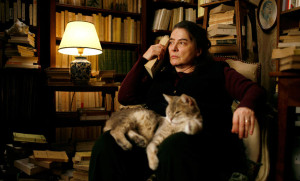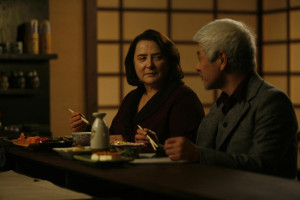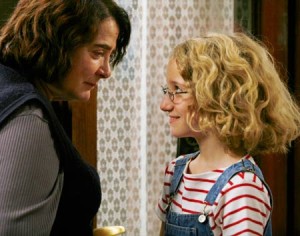Genre: Novel/ Fiction – My rating: 1 star…if possible, zero!
Citing Caryn James of “The New York Times” that summarize with: “ ‘The Elegance of the Hedgehog’, a best seller in France and several other countries, belongs to a distinct sub-genre: an accessible book that flatters readers with its intellectual veneer”, but… it didn’t convince me. At all.
Muriel Barbery’s effort after a well-received debut Une Gourmandaise (trans. “The Craving”), is the perfect introductory foray into those neophytes who consider the world of translated fiction intimidating.
Barbery introduces two narrators that are both extremely intelligent and reside in the same building at 7, rue de Grenelle (that’s the Left Bank in Paris). Right from the novel’s early stretch, Barbery, a professor of philosophy, seems too clever for her own good. It seems this first half of the book is an excuse for the author’s long academic digressions on Kant, phenomenology, William Ockham and Tolstoi. However, the philosophical presence is not inherent in either of the narrator’s points-of-view, as in many French novels, but it is used as more of a literary accessory for both Renée and Paloma (the two narrator voices) —something to demonstrate an element of their character. Because it is a commercial novel, the lack of philosophical depth is overshadowed by Barbery’s statement on French society and the novel’s sentimentality. In just a few pages, her main character, the concierge Renée, offers a mini-treatise on phenomenology.
The pattern threatens to become more calculated than graceful; the brief chapters, more essays than fiction, so carefully build in explanations for the literary and philosophical references that the author seems to be assessing what a mass audience needs.
These two narrators alternate the chapters, but the book is dominated by Renée, a widowed concierge in her 50s who calls herself “short, ugly and plump,” a self-consciously stereotypical working-class nobody. She is also an autodidact — “a permanent traitor to my archetype,” as she drolly puts it — who takes refuge in aesthetics and ideas but thinks life will be easier if she never lets her knowledge show. Even the slippers she wears as camouflage, she says, are so typical, “only the coalition between a baguette and a beret could possibly contend in the domain of cliché.”

Her unlikely counterpart is Paloma, a precocious 12-year-old whose family lives in a large apartment in the fashionable building Renée cares for. It’s just one of the many benefits of being the daughter of a former high-up French governmental official and not appreciating this luck makes her seem as vacuous and narcissistic as a stereotypical rich person. Paloma believes the world is so meaningless that she plans to commit suicide when she turns 13. The child (not yet a teenager) with abnormally high IQ and suicidal tendencies is not a credible character to me. Alice in Wonderland sounded more realistic in her whole.
Yet Paloma sees herself as a waste for this world, she feels underestimated and misunderstood and presents bitter and cynical observations about her parents, her sister, the family friends but really, she is not lacking for anything except for a frivolous mother that barely listen to this child of hers.
Although disliking your family is pretty normal in adolescence, here in the book it’s not clear why such a drama that lead to suicide thoughts…at 12 years old. A bit more attention to this child emotional side (instead of making her sound like a 50-year-old philosopher) might have made this character more interesting, but c’est la vie.
Renée’s story is addressed to no one, while Paloma’s takes the form of a notebook crammed with what she labels “profound thoughts.” Both create eloquent little essays on time, beauty and the meaning of life, Renée with erudition and Paloma with adolescent brio. Neither character realizes they share such similar views, from “the pointlessness of my existence,” as Renée says, to their affection for Japanese culture. Paloma adores reading manga, while Renée goes into raptures over an Ozu scene in which the violet mountains of Kyoto become a soul-saving vision of beauty.
Both of them skewer the class-conscious people in the building: Paloma observes the inanity of her politician father and Flaubert-quoting mother, while Renée knows that such supposedly bright lights never see past the net shopping bag she carries, its epicurean food hidden beneath turnips. The sharp-eyed Paloma guesses that Renée has “the same simple refinement as the hedgehog,” quills on the outside but “fiercely solitary — and terribly elegant” within.
So we have alternating über-intelligent narrators that are disregarded by the preoccupied wealthy inhabitants of the building. Perhaps it is necessary to understand the nuances of Parisian classism, but the self-consumed wealthy elitist is known in all societies and gives us a hollow, stock cliché that isn’t quite believable.
I found it a bit snob in itself that because she is a concierge who works in a building populated by rich and powerful people, it’s obvious they barely notice her existence. Renée is convinced that people from different social classes should not interact or become friends. She is also a closet intellectual who reads Kant and Tolstoy in secret and she frequently try to prove that to us by digressing into asides about more philosophy, culture, and other topics.
She reads Husserl, loves American blockbusters, the Japanese director Ozu, and her best friend, the maid Manuela. We learn of Renée’s insecurities about class difference and her fear of presenting herself as a smart, well-read person with provocative and valid opinions. It’s not clear what she fears, what might actually happen if the owners learned she is an intellectual. Probably nothing.
I guess you’d have to be French to understand this? But you don’t have to be French to feel smug and superior about reading this pretentious novel. Both the main characters are hypocritical snobs who accuse others of snobbery.
This intolerance is forgivable in a child perhaps, but not in a 54 year old concierge so incredibly tendentious and judgmental. Both Renée and Paloma think themselves unconventional, yet they are extremely ordinary in their views.
They are humorless (this is not a funny book) and they mock everyone they know regarding themselves as superior beings. All of their thinking is clichéd, their stale opinions are expressed with narcissistic melodrama and hyperbole, in elevated tones and stilted diction. The book is full of stereotypes and the awkward “plot” serves as a skeleton for a host of trite, sophomoric ideas.
The bad – at first it comes across as pompous and trying far too hard to be clever. There are long philosophical passages which add nothing to the characters or the story. A few basic philosophical problems are rehashed in reductive ways.
The writing is terrible: affected and clumsy. The author expectations toward the reader to sympathize with Renée failed miserably since she is boring and self-pitying, she vaunts her superior intelligence, is very self-involved, and yet fancies herself compassionate. Ironically, both characters all disdain the snobbism of the rich, yet at the same practice snobbism themselves. Even when the novel is most essayistic, the narrators’ kinetic minds and slowly-engaging voices (in Alison Anderson’s fluent translation) propel us ahead. Nothing is really going on: the plot is entirely centered on the interior monologues of two characters, it is light on what you might call “action.” It’s a novel of conversations and self-reflections, and takes place almost entirely within the confines of the apartment building.
The good – Renée’s and Paloma’s worlds are turned upside down by the arrival of an older, rich (and perfect and egalitarian) Japanese gentleman, Kakuro, who sees them for whom they really are and brings them out of their shells. Once the new tenant arrives the main characters all become more likeable and interesting. Finally, someone besides the reader to recognize Renée’s intellectual value and Paloma’s mental acuity and to satisfy both of their Japanese fixations.

We like what Kakuro represents—a nice, intelligent person who seeks out other nice, intelligent people—and that he presents himself as person who actually likes Renée despite his own wealth and her lack of it. And for Paloma, Kakuro becomes what her parents cannot, a positive role model with money. The lives of both characters perk up with this mysterious and charmingly attentive character (His name alone, Kakuro Ozu, is enough to tantalize Renée, and he doesn’t disappoint her. “You pace up and down a corridor and suddenly enter a room full of light,” she says of their friendship) and his presence also brightens the book, adding emotion and an actual story.
To be honest, all the pedantic asides left me cold. They took me out of the story and weren’t all that interesting. Similarly, if I poke holes in the characterization or plot, it might sound as if I didn’t understand or failed to appreciate the depth of this book. It’s therefore fair saying that the book had some better moments, interesting metaphors and was quite readable, but I cannot give it more than that.
I still wonder why everyone in France recommended (and still does) this book. I mean it in a positive way, I’m genuine curious to know it.
It is one of the most pretentious, banal “novels” I’ve ever read. I expected something nearly transcendent. But instead “The Elegance of the Hedgehog” is predictable, overly politically correct and quite pretentious. It lacked depth and heart, and I blame this on the stilted half-epistolary/half-first-person narrative style that Barbery employs.
Overall, I would NOT recommend this book.
I got a good vibe by Alison Anderson’s translation which is capable, though quite literal, but anyway a perfect introduction to the world of modern translated literature.
Valentina Caprio
‘The Elegance of the Hedgehog’ by Muriel Barbery – my review


